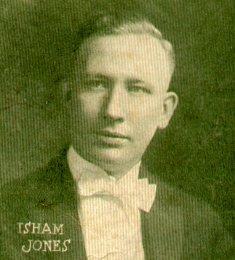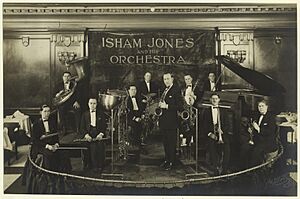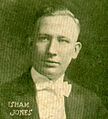Isham Jones facts for kids
Quick facts for kids
Isham Jones
|
|
|---|---|

Isham Jones, 1922
|
|
| Background information | |
| Birth name | Isham Edgar Jones |
| Born | January 31, 1894 Coalton, Ohio, U.S. |
| Origin | Saginaw, Michigan, U.S. |
| Died | October 19, 1956 (aged 62) Hollywood, Florida, U.S. |
| Genres | Dance band |
| Occupation(s) |
|
| Instruments |
|
| Years active | 1911–1938 |
| Labels |
|
| Associated acts |
|
Isham Edgar Jones (born January 31, 1894 – died October 19, 1956) was a famous American bandleader, musician, and songwriter. He played the saxophone and bass.
Contents
The Musical Journey of Isham Jones
Isham Jones was born in Coalton, Ohio, USA. His family loved music, and his father was a violinist. He grew up in Saginaw, Michigan, where he started his first music group for church shows. In 1911, he wrote one of his first songs, "On the Alamo."
In 1915, Isham moved to Chicago, Illinois. He played music at popular places like Green Mill Gardens and Rainbo Gardens. Chicago was his home until 1932, when he moved to New York City. He even took his orchestra on a tour to England in 1925.
In 1917, he wrote the song "We're in the Army Now." This song became very popular during World War I and World War II. The U.S. Army Band still plays it today.
Isham Jones led one of the most popular dance bands in the 1920s and 1930s. His band made many popular gramophone records for Brunswick Records. Their first 26 recordings were called "Isham Jones' Rainbo Orchestra." Later, they were simply "Isham Jones' Orchestra."
His first big hit song was "Wabash Blues" in 1921. This song sold over a million copies! It stayed at number one on the U.S. charts for six weeks. It even won a gold disc award.
Many famous musicians played in Jones's band. These included Louis Panico, Benny Goodman, Woody Herman, and Roy Bargy.
Recording Success and New Sounds
Isham Jones's records for Brunswick were popular from the start. He took a break from recording between October 1927 and June 1929. This was because he was reorganizing his band.
From 1929 to 1932, his Brunswick recordings became even more advanced. They featured cool arrangements by Gordon Jenkins and others. Jones also started to feature violinists like Eddie Stone and Joe Martin as singers. In 1932, the famous singer Bing Crosby recorded two songs with Jones's band, including "Sweet Georgia Brown."
In August 1932, Jones signed with Victor Records. Many people think these recordings are some of the best dance band records from the Great Depression era. Victor's recording style really suited Jones's band. His Victor songs often had a grand, almost symphonic sound. He stayed with Victor until July 1934.
After Victor, he signed with Decca Records. Some people don't think his Decca recordings were as good. This might be because of Decca's recording methods or because his orchestra seemed smaller. After leaving Decca in 1936, he retired again. His band was then taken over by Woody Herman.
Jones started a new band in 1937–38. They recorded a few songs for labels like Melotone, Perfect, and Banner.
Later Life and Legacy
In the 1940s, Isham Jones lived on his poultry farm in Colorado. He sometimes left the farm for short music tours. Later, he lived in Los Angeles. In 1955, he moved to Hollywood, Florida. He sadly passed away there from cancer in 1956.
His great-nephew, Rusty Jones, also became a jazz drummer.
Famous Songs by Isham Jones
Isham Jones was a very successful songwriter. He wrote many songs that topped the music charts. He often worked with lyricist Gus Kahn. Here are some of his well-known compositions:
- "Broken Hearted Melody" (1922)
- "I'll See You in My Dreams" (1924) – This song was number one for seven weeks!
- "It Had to Be You" (1924) – This was number one for five weeks!
- "On the Alamo" (1922) – Number one for four weeks.
- "The One I Love (Belongs to Somebody Else)" (1924)
- "Spain" (1924) – Number one for two weeks.
- "Swingin' Down the Lane" (1923) – Number one for six weeks.
- "There Is No Greater Love" (1936)
- "We're In The Army Now" (1917)
- "You're Just a Dream Come True" (1931) – This was his theme song.
Other Popular Recordings
Isham Jones's band also had hits with songs written by other composers. Here are a few:
- "Wabash Blues" (1921) – This was a huge hit, number one for six weeks!
- "The World Is Waiting for the Sunrise" (1922)
- "Who's Sorry Now?" (1923)
- "California Here I Come" (1924) – Number one for six weeks.
- "Sweet Georgia Brown" (1925)
- "Remember" (1925) – Number one for one week.
- "Stardust" (1930) – One of the best-selling versions of this famous song.
Discography
- Happy: The 1920 Rainbo Orchestra Sides (2014)
- Song of the Blues (1923-1932) (2008)
- Shadows on the Swanee (1932-1934) (2013)
Honors and Awards
- 1989 – Isham Jones was added to the Big Band and Jazz Hall of Fame. He was also honored in the Songwriters Hall of Fame.
- 2007 – His song "It Had to Be You" was put into the Grammy Hall of Fame.
Images for kids
See also
 In Spanish: Isham Jones para niños
In Spanish: Isham Jones para niños



